BUS-FP4013: Mechanistic vs. Organic Organizational Structures
VerifiedAdded on 2022/09/12
|7
|1407
|10
Report
AI Summary
This report provides a detailed analysis of mechanistic and organic organizational structures. It begins by defining each structure, highlighting key characteristics such as departmentalization, formalization, centralization, and information networks for mechanistic structures, and cross-functional teams, low formalization, and employee participation for organic structures. The report then compares and contrasts these structures, emphasizing the authoritarian nature of mechanistic models versus the participative approach of organic models. It explores how environmental changes, particularly the shift towards creativity and innovation, favor organic structures. The report examines the impact of each structure on decision-making speed and competitiveness, ultimately advocating for the organic model in today's dynamic business environment. The report concludes by emphasizing the importance of organizational structure in fostering innovation, achieving competitive advantage, and successfully navigating globalization.
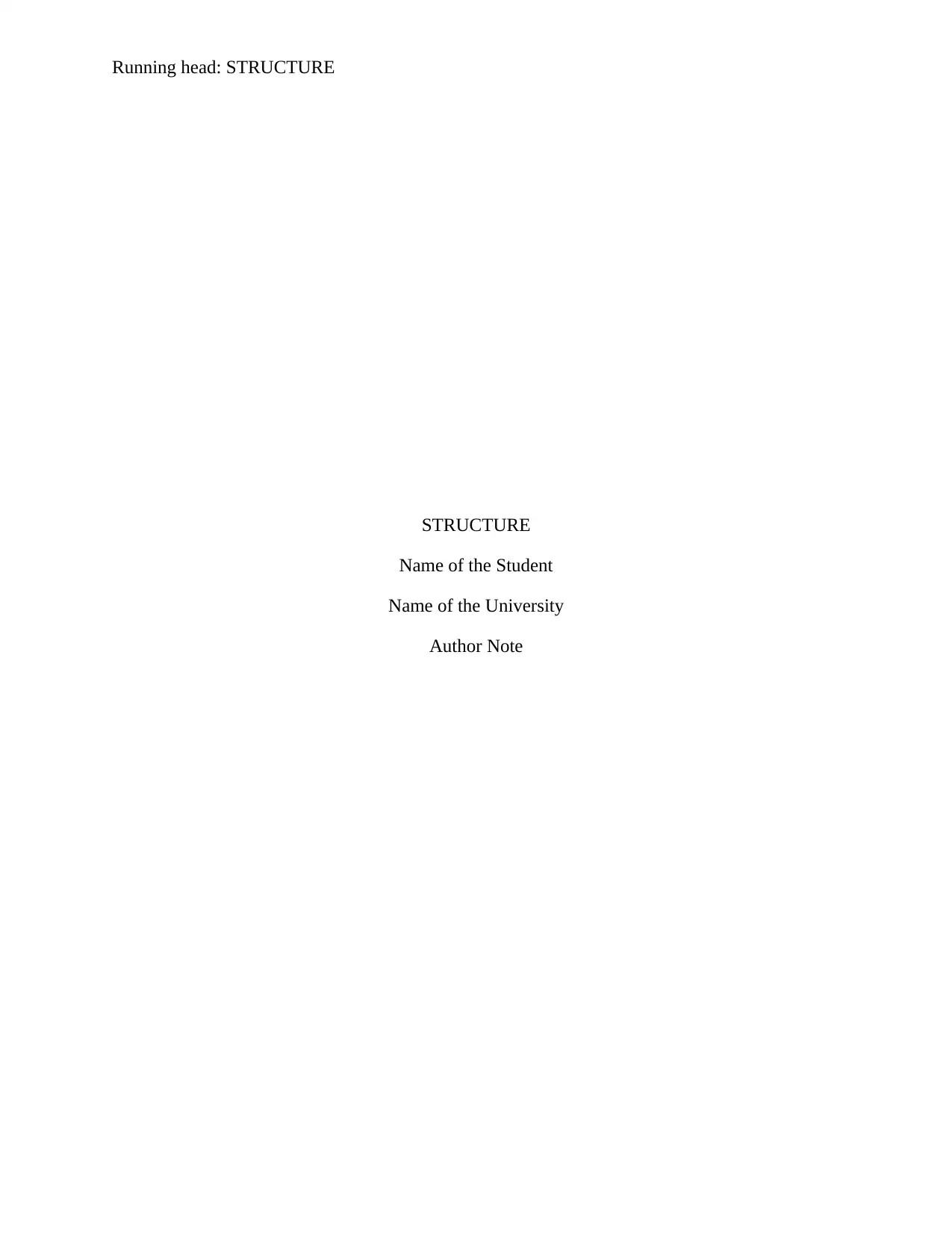
Running head: STRUCTURE
STRUCTURE
Name of the Student
Name of the University
Author Note
STRUCTURE
Name of the Student
Name of the University
Author Note
Paraphrase This Document
Need a fresh take? Get an instant paraphrase of this document with our AI Paraphraser
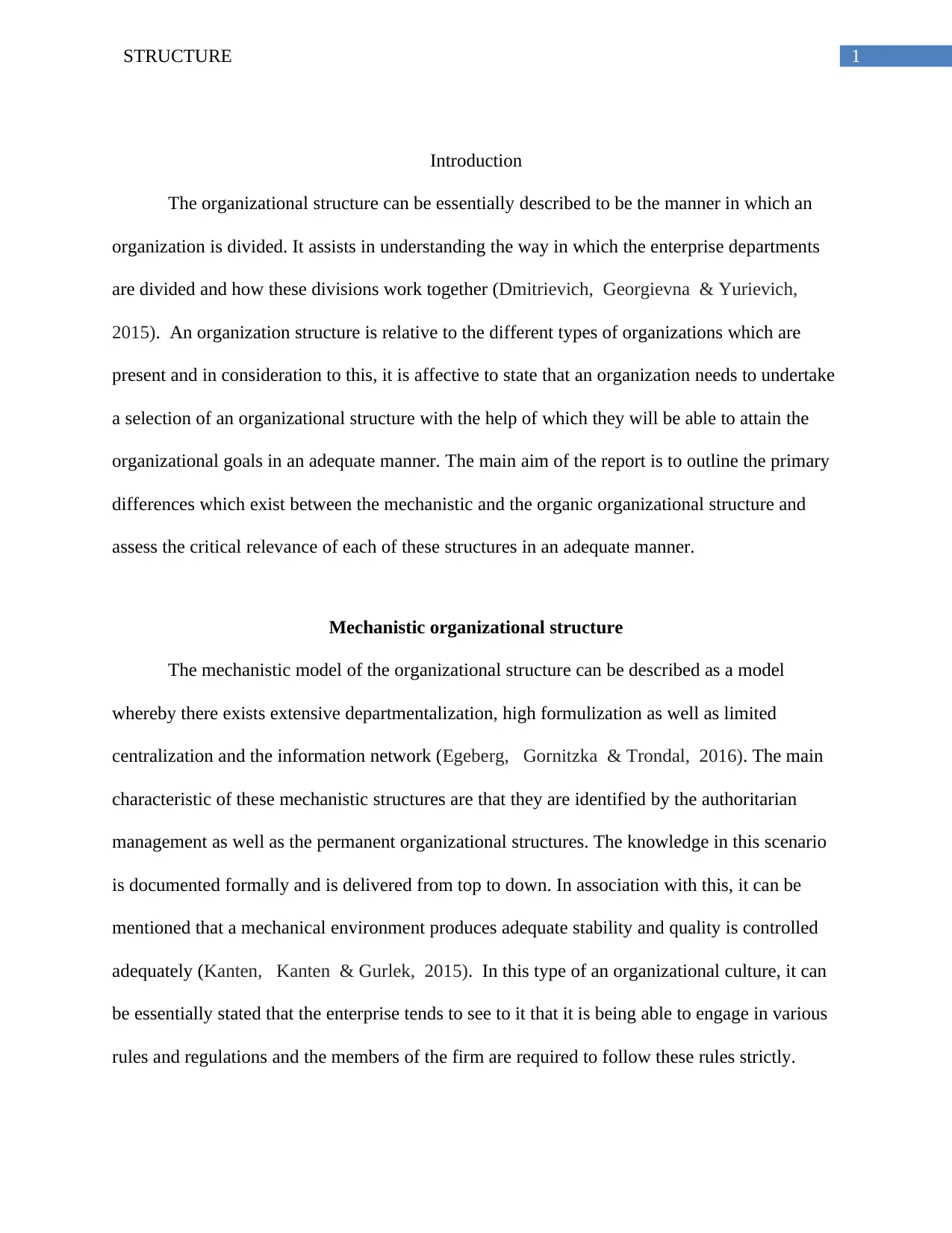
1STRUCTURE
Introduction
The organizational structure can be essentially described to be the manner in which an
organization is divided. It assists in understanding the way in which the enterprise departments
are divided and how these divisions work together (Dmitrievich, Georgievna & Yurievich,
2015). An organization structure is relative to the different types of organizations which are
present and in consideration to this, it is affective to state that an organization needs to undertake
a selection of an organizational structure with the help of which they will be able to attain the
organizational goals in an adequate manner. The main aim of the report is to outline the primary
differences which exist between the mechanistic and the organic organizational structure and
assess the critical relevance of each of these structures in an adequate manner.
Mechanistic organizational structure
The mechanistic model of the organizational structure can be described as a model
whereby there exists extensive departmentalization, high formulization as well as limited
centralization and the information network (Egeberg, Gornitzka & Trondal, 2016). The main
characteristic of these mechanistic structures are that they are identified by the authoritarian
management as well as the permanent organizational structures. The knowledge in this scenario
is documented formally and is delivered from top to down. In association with this, it can be
mentioned that a mechanical environment produces adequate stability and quality is controlled
adequately (Kanten, Kanten & Gurlek, 2015). In this type of an organizational culture, it can
be essentially stated that the enterprise tends to see to it that it is being able to engage in various
rules and regulations and the members of the firm are required to follow these rules strictly.
Introduction
The organizational structure can be essentially described to be the manner in which an
organization is divided. It assists in understanding the way in which the enterprise departments
are divided and how these divisions work together (Dmitrievich, Georgievna & Yurievich,
2015). An organization structure is relative to the different types of organizations which are
present and in consideration to this, it is affective to state that an organization needs to undertake
a selection of an organizational structure with the help of which they will be able to attain the
organizational goals in an adequate manner. The main aim of the report is to outline the primary
differences which exist between the mechanistic and the organic organizational structure and
assess the critical relevance of each of these structures in an adequate manner.
Mechanistic organizational structure
The mechanistic model of the organizational structure can be described as a model
whereby there exists extensive departmentalization, high formulization as well as limited
centralization and the information network (Egeberg, Gornitzka & Trondal, 2016). The main
characteristic of these mechanistic structures are that they are identified by the authoritarian
management as well as the permanent organizational structures. The knowledge in this scenario
is documented formally and is delivered from top to down. In association with this, it can be
mentioned that a mechanical environment produces adequate stability and quality is controlled
adequately (Kanten, Kanten & Gurlek, 2015). In this type of an organizational culture, it can
be essentially stated that the enterprise tends to see to it that it is being able to engage in various
rules and regulations and the members of the firm are required to follow these rules strictly.
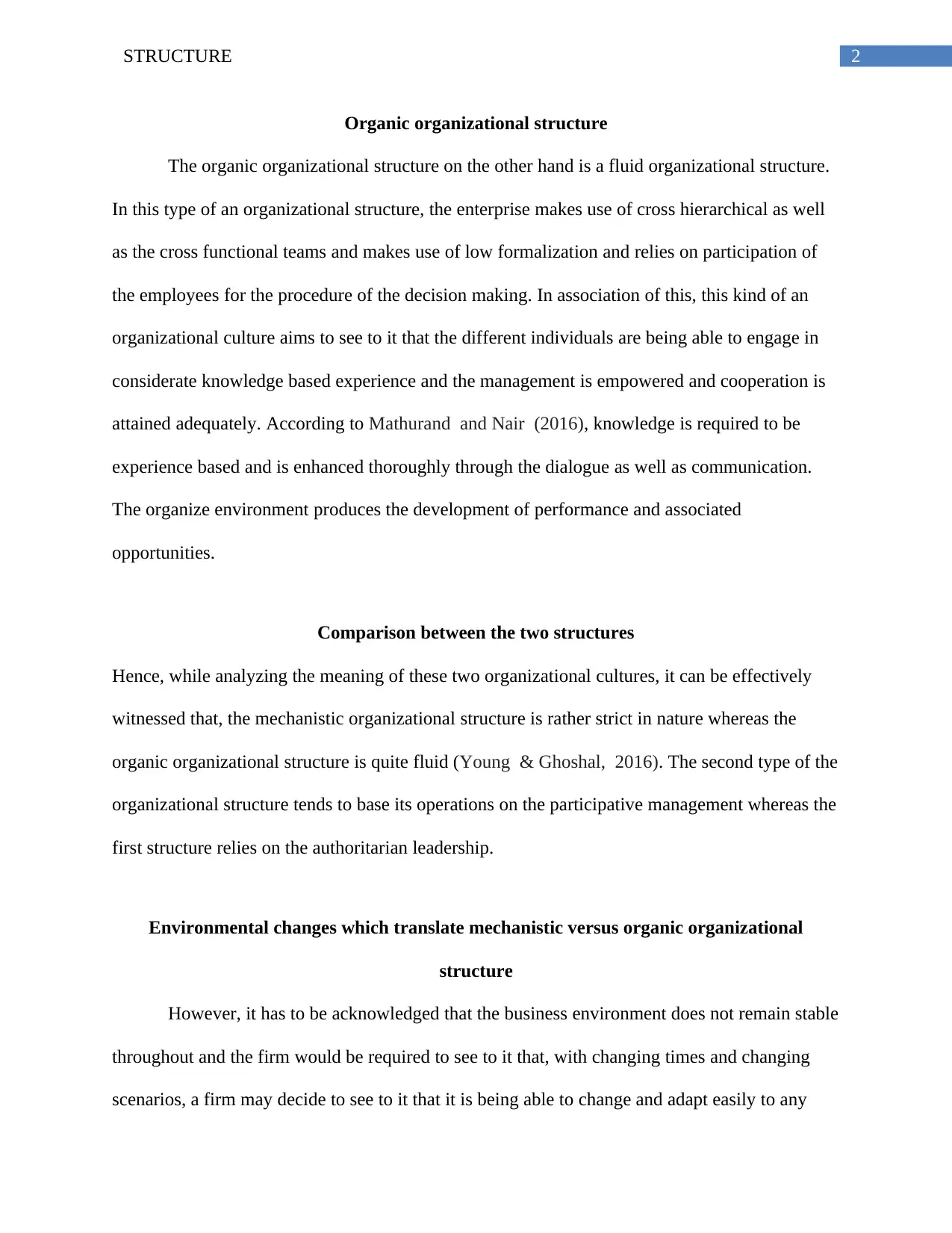
2STRUCTURE
Organic organizational structure
The organic organizational structure on the other hand is a fluid organizational structure.
In this type of an organizational structure, the enterprise makes use of cross hierarchical as well
as the cross functional teams and makes use of low formalization and relies on participation of
the employees for the procedure of the decision making. In association of this, this kind of an
organizational culture aims to see to it that the different individuals are being able to engage in
considerate knowledge based experience and the management is empowered and cooperation is
attained adequately. According to Mathurand and Nair (2016), knowledge is required to be
experience based and is enhanced thoroughly through the dialogue as well as communication.
The organize environment produces the development of performance and associated
opportunities.
Comparison between the two structures
Hence, while analyzing the meaning of these two organizational cultures, it can be effectively
witnessed that, the mechanistic organizational structure is rather strict in nature whereas the
organic organizational structure is quite fluid (Young & Ghoshal, 2016). The second type of the
organizational structure tends to base its operations on the participative management whereas the
first structure relies on the authoritarian leadership.
Environmental changes which translate mechanistic versus organic organizational
structure
However, it has to be acknowledged that the business environment does not remain stable
throughout and the firm would be required to see to it that, with changing times and changing
scenarios, a firm may decide to see to it that it is being able to change and adapt easily to any
Organic organizational structure
The organic organizational structure on the other hand is a fluid organizational structure.
In this type of an organizational structure, the enterprise makes use of cross hierarchical as well
as the cross functional teams and makes use of low formalization and relies on participation of
the employees for the procedure of the decision making. In association of this, this kind of an
organizational culture aims to see to it that the different individuals are being able to engage in
considerate knowledge based experience and the management is empowered and cooperation is
attained adequately. According to Mathurand and Nair (2016), knowledge is required to be
experience based and is enhanced thoroughly through the dialogue as well as communication.
The organize environment produces the development of performance and associated
opportunities.
Comparison between the two structures
Hence, while analyzing the meaning of these two organizational cultures, it can be effectively
witnessed that, the mechanistic organizational structure is rather strict in nature whereas the
organic organizational structure is quite fluid (Young & Ghoshal, 2016). The second type of the
organizational structure tends to base its operations on the participative management whereas the
first structure relies on the authoritarian leadership.
Environmental changes which translate mechanistic versus organic organizational
structure
However, it has to be acknowledged that the business environment does not remain stable
throughout and the firm would be required to see to it that, with changing times and changing
scenarios, a firm may decide to see to it that it is being able to change and adapt easily to any
⊘ This is a preview!⊘
Do you want full access?
Subscribe today to unlock all pages.

Trusted by 1+ million students worldwide
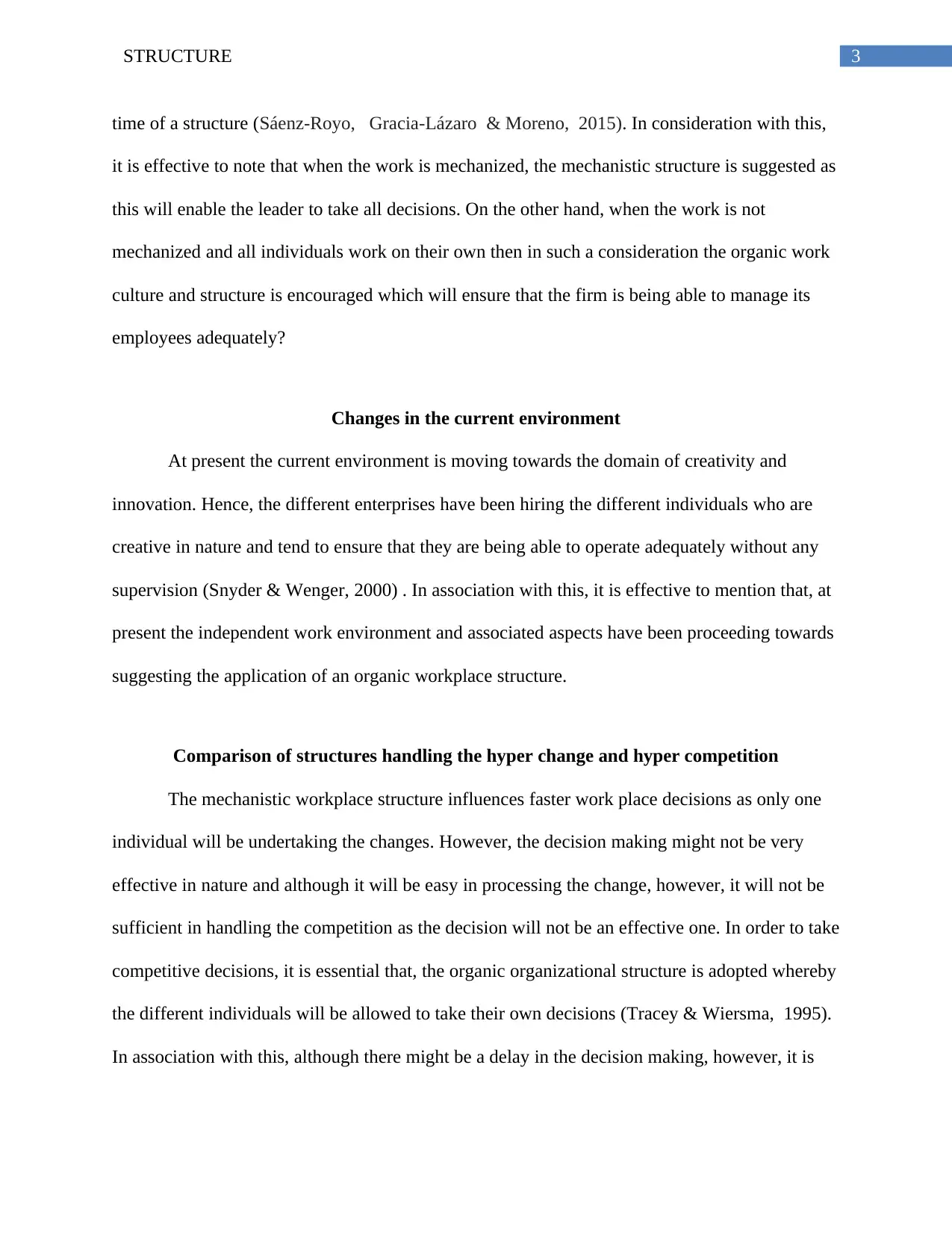
3STRUCTURE
time of a structure (Sáenz-Royo, Gracia-Lázaro & Moreno, 2015). In consideration with this,
it is effective to note that when the work is mechanized, the mechanistic structure is suggested as
this will enable the leader to take all decisions. On the other hand, when the work is not
mechanized and all individuals work on their own then in such a consideration the organic work
culture and structure is encouraged which will ensure that the firm is being able to manage its
employees adequately?
Changes in the current environment
At present the current environment is moving towards the domain of creativity and
innovation. Hence, the different enterprises have been hiring the different individuals who are
creative in nature and tend to ensure that they are being able to operate adequately without any
supervision (Snyder & Wenger, 2000) . In association with this, it is effective to mention that, at
present the independent work environment and associated aspects have been proceeding towards
suggesting the application of an organic workplace structure.
Comparison of structures handling the hyper change and hyper competition
The mechanistic workplace structure influences faster work place decisions as only one
individual will be undertaking the changes. However, the decision making might not be very
effective in nature and although it will be easy in processing the change, however, it will not be
sufficient in handling the competition as the decision will not be an effective one. In order to take
competitive decisions, it is essential that, the organic organizational structure is adopted whereby
the different individuals will be allowed to take their own decisions (Tracey & Wiersma, 1995).
In association with this, although there might be a delay in the decision making, however, it is
time of a structure (Sáenz-Royo, Gracia-Lázaro & Moreno, 2015). In consideration with this,
it is effective to note that when the work is mechanized, the mechanistic structure is suggested as
this will enable the leader to take all decisions. On the other hand, when the work is not
mechanized and all individuals work on their own then in such a consideration the organic work
culture and structure is encouraged which will ensure that the firm is being able to manage its
employees adequately?
Changes in the current environment
At present the current environment is moving towards the domain of creativity and
innovation. Hence, the different enterprises have been hiring the different individuals who are
creative in nature and tend to ensure that they are being able to operate adequately without any
supervision (Snyder & Wenger, 2000) . In association with this, it is effective to mention that, at
present the independent work environment and associated aspects have been proceeding towards
suggesting the application of an organic workplace structure.
Comparison of structures handling the hyper change and hyper competition
The mechanistic workplace structure influences faster work place decisions as only one
individual will be undertaking the changes. However, the decision making might not be very
effective in nature and although it will be easy in processing the change, however, it will not be
sufficient in handling the competition as the decision will not be an effective one. In order to take
competitive decisions, it is essential that, the organic organizational structure is adopted whereby
the different individuals will be allowed to take their own decisions (Tracey & Wiersma, 1995).
In association with this, although there might be a delay in the decision making, however, it is
Paraphrase This Document
Need a fresh take? Get an instant paraphrase of this document with our AI Paraphraser
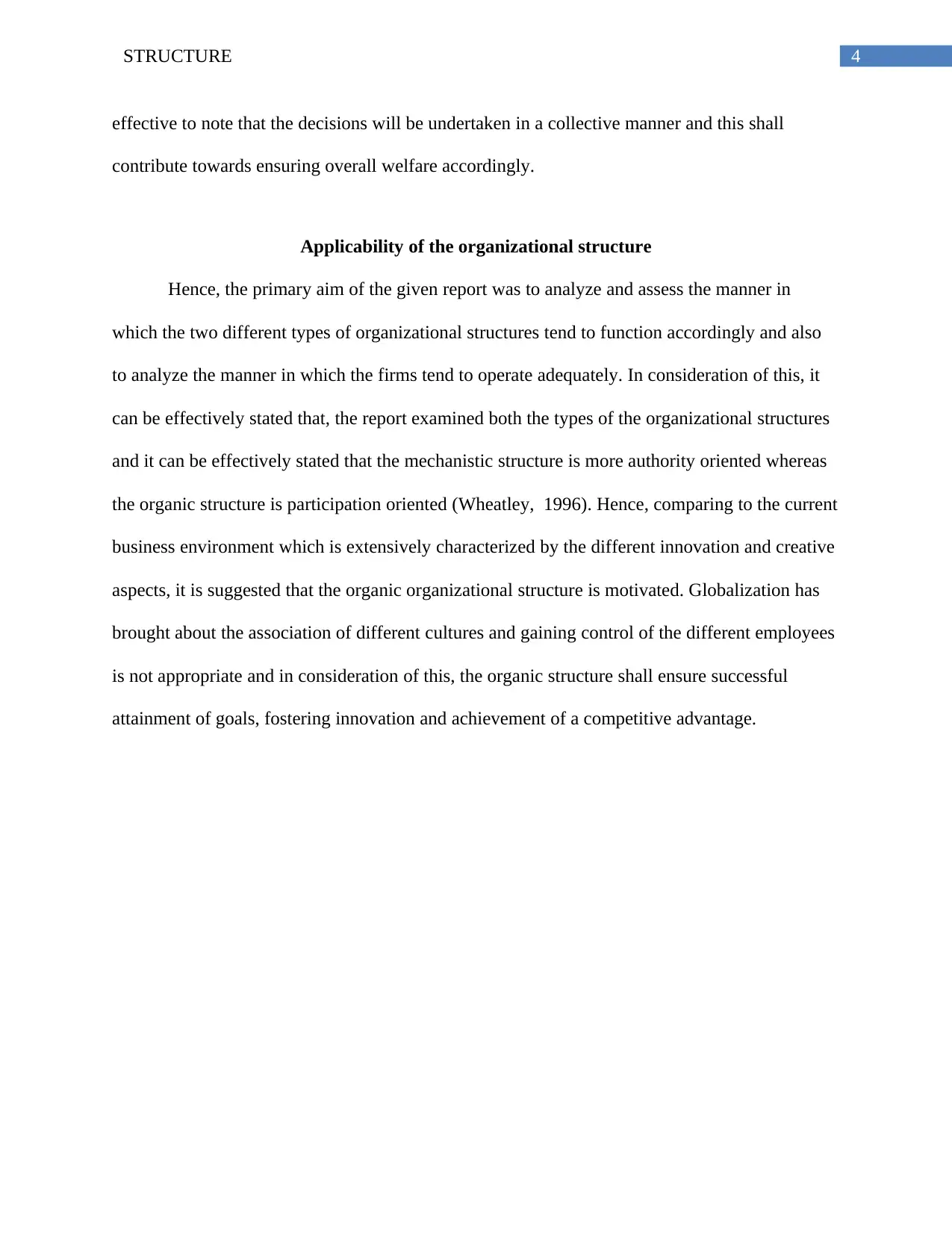
4STRUCTURE
effective to note that the decisions will be undertaken in a collective manner and this shall
contribute towards ensuring overall welfare accordingly.
Applicability of the organizational structure
Hence, the primary aim of the given report was to analyze and assess the manner in
which the two different types of organizational structures tend to function accordingly and also
to analyze the manner in which the firms tend to operate adequately. In consideration of this, it
can be effectively stated that, the report examined both the types of the organizational structures
and it can be effectively stated that the mechanistic structure is more authority oriented whereas
the organic structure is participation oriented (Wheatley, 1996). Hence, comparing to the current
business environment which is extensively characterized by the different innovation and creative
aspects, it is suggested that the organic organizational structure is motivated. Globalization has
brought about the association of different cultures and gaining control of the different employees
is not appropriate and in consideration of this, the organic structure shall ensure successful
attainment of goals, fostering innovation and achievement of a competitive advantage.
effective to note that the decisions will be undertaken in a collective manner and this shall
contribute towards ensuring overall welfare accordingly.
Applicability of the organizational structure
Hence, the primary aim of the given report was to analyze and assess the manner in
which the two different types of organizational structures tend to function accordingly and also
to analyze the manner in which the firms tend to operate adequately. In consideration of this, it
can be effectively stated that, the report examined both the types of the organizational structures
and it can be effectively stated that the mechanistic structure is more authority oriented whereas
the organic structure is participation oriented (Wheatley, 1996). Hence, comparing to the current
business environment which is extensively characterized by the different innovation and creative
aspects, it is suggested that the organic organizational structure is motivated. Globalization has
brought about the association of different cultures and gaining control of the different employees
is not appropriate and in consideration of this, the organic structure shall ensure successful
attainment of goals, fostering innovation and achievement of a competitive advantage.
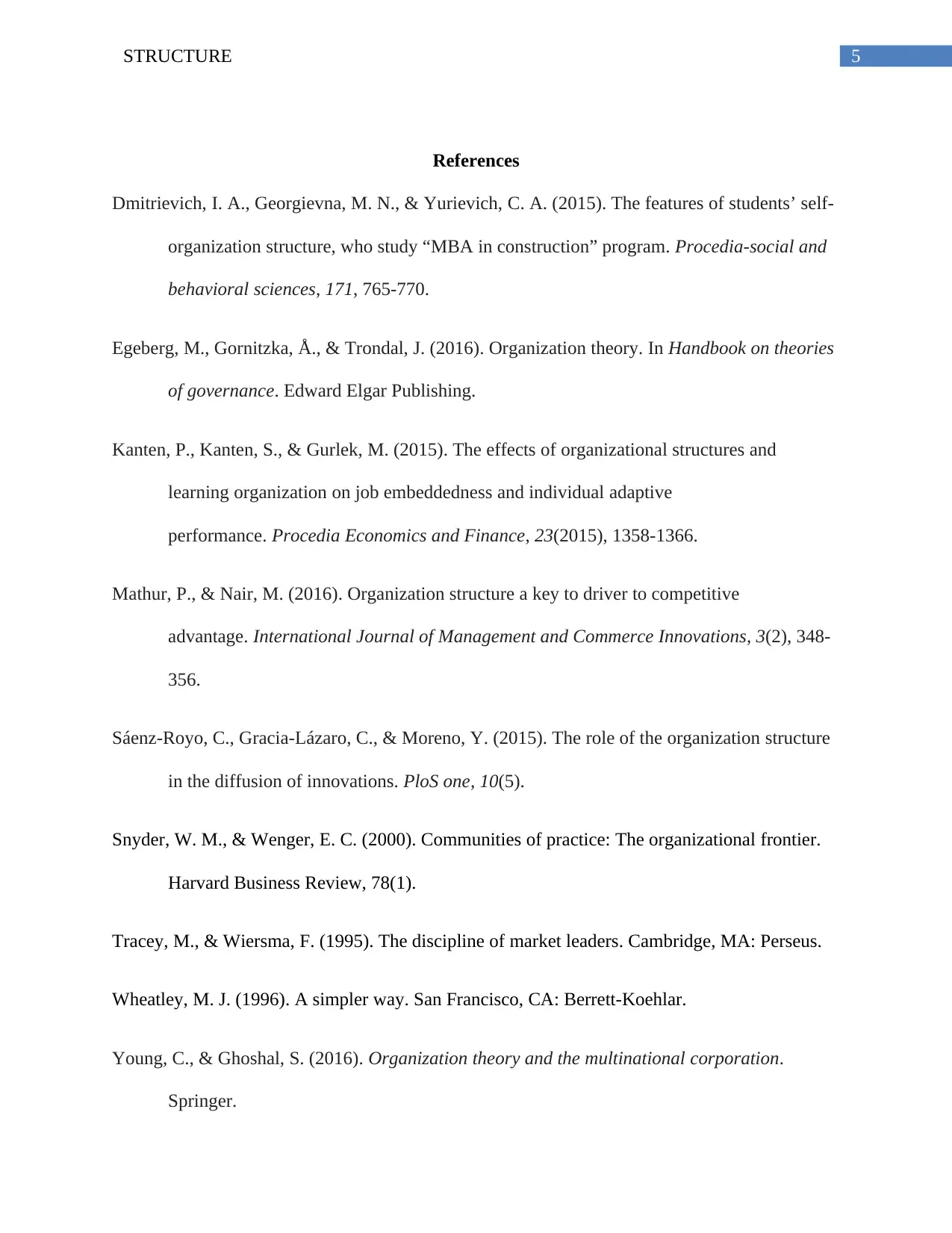
5STRUCTURE
References
Dmitrievich, I. A., Georgievna, M. N., & Yurievich, C. A. (2015). The features of students’ self-
organization structure, who study “MBA in construction” program. Procedia-social and
behavioral sciences, 171, 765-770.
Egeberg, M., Gornitzka, Å., & Trondal, J. (2016). Organization theory. In Handbook on theories
of governance. Edward Elgar Publishing.
Kanten, P., Kanten, S., & Gurlek, M. (2015). The effects of organizational structures and
learning organization on job embeddedness and individual adaptive
performance. Procedia Economics and Finance, 23(2015), 1358-1366.
Mathur, P., & Nair, M. (2016). Organization structure a key to driver to competitive
advantage. International Journal of Management and Commerce Innovations, 3(2), 348-
356.
Sáenz-Royo, C., Gracia-Lázaro, C., & Moreno, Y. (2015). The role of the organization structure
in the diffusion of innovations. PloS one, 10(5).
Snyder, W. M., & Wenger, E. C. (2000). Communities of practice: The organizational frontier.
Harvard Business Review, 78(1).
Tracey, M., & Wiersma, F. (1995). The discipline of market leaders. Cambridge, MA: Perseus.
Wheatley, M. J. (1996). A simpler way. San Francisco, CA: Berrett-Koehlar.
Young, C., & Ghoshal, S. (2016). Organization theory and the multinational corporation.
Springer.
References
Dmitrievich, I. A., Georgievna, M. N., & Yurievich, C. A. (2015). The features of students’ self-
organization structure, who study “MBA in construction” program. Procedia-social and
behavioral sciences, 171, 765-770.
Egeberg, M., Gornitzka, Å., & Trondal, J. (2016). Organization theory. In Handbook on theories
of governance. Edward Elgar Publishing.
Kanten, P., Kanten, S., & Gurlek, M. (2015). The effects of organizational structures and
learning organization on job embeddedness and individual adaptive
performance. Procedia Economics and Finance, 23(2015), 1358-1366.
Mathur, P., & Nair, M. (2016). Organization structure a key to driver to competitive
advantage. International Journal of Management and Commerce Innovations, 3(2), 348-
356.
Sáenz-Royo, C., Gracia-Lázaro, C., & Moreno, Y. (2015). The role of the organization structure
in the diffusion of innovations. PloS one, 10(5).
Snyder, W. M., & Wenger, E. C. (2000). Communities of practice: The organizational frontier.
Harvard Business Review, 78(1).
Tracey, M., & Wiersma, F. (1995). The discipline of market leaders. Cambridge, MA: Perseus.
Wheatley, M. J. (1996). A simpler way. San Francisco, CA: Berrett-Koehlar.
Young, C., & Ghoshal, S. (2016). Organization theory and the multinational corporation.
Springer.
⊘ This is a preview!⊘
Do you want full access?
Subscribe today to unlock all pages.

Trusted by 1+ million students worldwide

6STRUCTURE
1 out of 7
Related Documents
Your All-in-One AI-Powered Toolkit for Academic Success.
+13062052269
info@desklib.com
Available 24*7 on WhatsApp / Email
![[object Object]](/_next/static/media/star-bottom.7253800d.svg)
Unlock your academic potential
Copyright © 2020–2025 A2Z Services. All Rights Reserved. Developed and managed by ZUCOL.





